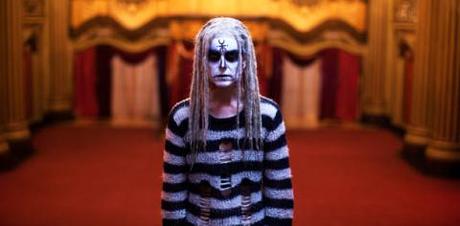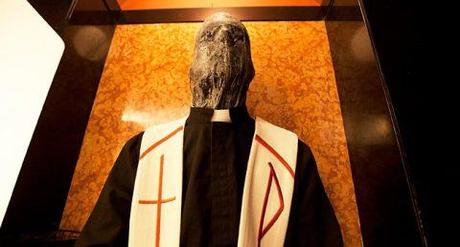
by Steve Habrat
Rob Zombie could be one of the most polarizing individuals working in the horror industry. The mere mention of his name in a conversation can elicit either groans or praise, depending on that person’s taste in horror. Whether you love him or hate him, it’s undeniable that the man leaves a strong impression. It’s been four years since Zombie’s Halloween II, his reluctant sequel to his grisly 2007 remake of the John Carpenter slasher classic Halloween, and it’s been eight years since he unleashed The Devil’s Rejects, what is considered by many to be his unholy masterpiece. With his creative juices following again, Zombie now gives his fans The Lords of Salem, a static departure from his usual brand of hillbillies-from-Hell horror. Clearly drawing inspiration from early Roman Polanski, Stanley Kubrick, and Kenneth Anger, Zombie makes one of the most ambitious films of his career and you have to hand it to him for attempting to show a bit of range outside of the handheld grittiness that he was limiting himself to. The Lords of Salem is overflowing with overcast atmosphere and it packs plenty of shock scares that thankfully aren’t accompanied by a deafening musical blast, but the final stretch of the film is weakened by a flurry of satanic images that would have seemed more at home in a heavy metal music video rather than a serious-minded horror film about the Salem witch trials.
Heidi LaRoq (played by Sheri Moon Zombie) is a recovering crack addict living in Salem, Massachusetts. She shacks up in a small apartment with her landlady Lacy Doyle (played by Judy Geeson) and she works at a local radio station as a DJ alongside Whitey (played Jeff Daniel Phillips) and Herman (played by Ken Foree). One day, the station’s receptionist presents Heidi with a wooden box that contains a record by a mysterious band called The Lords. Heidi, Whitey, and Herman decide to play the mysterious record on the air, but as the hypnotic music grinds out, Heidi begins to suffer from horrific hallucinations. The music captures the attention of local historian Francis Matthias (played by Bruce Davison), who believes that the music may have a link to a coven of witches that were referred to as The Lords of Salem and hunted by Reverend Jonathan Hawthorne (played by Andrew Prine) in 1696. As the days pass, Heidi’s visions grow more and more disturbing, but things get even more bizarre for Heidi when Lacy’s suspicious two sisters, Megan (played by Patricia Quinn) and Sonny (played by Dee Walace), suddenly arrive at the apartment complex.
Abandoning the bludgeoning violence that he has become known for, Zombie takes a radical new approach to The Lords of Salem. The film begins with a filthy flashback that finds a coven of witches led by Margaret Morgan (played by Meg Foster) huddled around a campfire in the nude and howling about Satan. It’s shrill and graphic, but then Zombie instantly abandons this assault in favor of hushed pacing that hums with evil. The weather is gray, the leaves suggest that it’s October, and the ghostly specters that haunt Heidi slowly make themselves known. The spirits are revealed when Heidi walks slowly past her bathroom or when she flips the light on in a darkened room, but they are not accompanied by some loud soundtrack cue to make us jump. Zombie simply lets their sudden presence alone creep us out and it is very effective. As the film inches along, the hallucinations become more and more severe, one of the most disturbing being a satanic sexual assault in a church that finds a priest coughing up black sludge and Heidi catching a glimpse of a faceless ghoul walking his pet goat through a cemetery. It’s some seriously wicked stuff that is just extreme enough to work.

The biggest change in Zombie’s aesthetic is the use of static cameras in place of the gritty handheld camerawork that House of 1000 Corpses, The Devil’s Rejects, Halloween, and Halloween II all applied. There are crisp outdoors shots that called to mind some of the early moments of The Exorcist and there are prolonged symmetrical shots that wouldn’t seem out of place in a Kubrick film, a director that Zombie heavily admires. At times, the story and even a few shots near the middle of the film were reminiscent of Polanski’s Repulsion and Rosemary’s Baby, especially the inclusion of the three sisters who may be up to no good just down the hall. The end of The Lords of Salem is where Zombie begins to loose his handle on things, as he fires a string of psychedelic satanic images that would make experimental filmmaker Kenneth Anger smile. These acid washed images are loaded with faceless priests clutching dildos, Heidi riding a goat, a demonic dwarf waiting at the top of a grand staircase, a satanic rocker groping the dreadlocked gal, and images of Christ’s face contorting into the face of the devil himself. These images will shock those who are easily offended, but as they unfold before us, they start to resemble a music video rather than anything we would have seen in Anger’s Inauguration of the Pleasure Dome. They complete destroy that atmosphere of doom that Zombie worked so hard to build up but he doesn’t seem to care because he thinks they look great.
As far as the performances go, Zombie manages to capture some downbeat work from a slew of cult actors and actresses. His previous four films were loaded with a cast of colorful psychos who all cursed like sailors and looked like unused extras from The Texas Chain Saw Massacre. This is not necessarily the case for The Lords of Salem, as these characters all seem to be a bit more grounded than anything he has ever come up with. Sheri Moon Zombie steps up her acting game as Heidi, the recovering drug addict that is seemingly on the right path to happiness. Watching her slip into a world of madness is harsh, but Zombie wants it that way. Jeff Daniel Phillips gives a softer performance as Whitey, Heidi’s love interest that just can’t seem to find a way into her life. Ken Foree is laid back cool as Herman, the smooth-talking DJ that really seems to serve no purpose at all to the story. It seems like Zombie included him in the film simply because he is a big fan of Foree’s work. Geeson shows some serious menace as Lacy, Heidi’s secretive landlord, Patricia Quinn is frizzy intensity as the palm-reading Megan, and Dee Wallace’s Sonny is peculiarly seductive. Rounding out the main cast members is Davison’s Francis, a concerned acquaintance who may be too late to save Heidi’s soul, and Meg Foster as the cackling hell spawn Margaret Morgan, who bares rotten fangs right in the viewer’s face.
Despite some of the drastic shifts, The Lords of Salem isn’t without Zombie’s cinematic fingerprints. The soundtrack is filled with classic rock like The Velvet Underground, Mannfred Mann’s Earth Band, and Rush, all which heavily compliment the retro 70s feel of the picture. Budget restraints seem to have prevented Zombie from actually setting the film in the 1970s, but you can tell he desperately wanted to, as every character is dressed like they stepped out of that era. While it is a bit spare, there are several fits of Zombie’s stomach churning violence. A witch licks amniotic fluids off a newborn baby, one character’s head is smashed into hamburger meat, and a gruesome birth accompanies the neon evil at the end. Overall, Zombie has claimed that The Lords of Salem is his final trip into horror and if this is true, it finds him bowing out on a confident and frankly refreshing note. It is a bit more mature even if the final moments give way to strobe light silliness that wouldn’t even shock your grandmother. The Lords of Salem is all about atmosphere and scares that will curl your spine.
Grade: B
The Lords of Salem is available on Blu-ray and DVD.
